The Québec maritime Blog
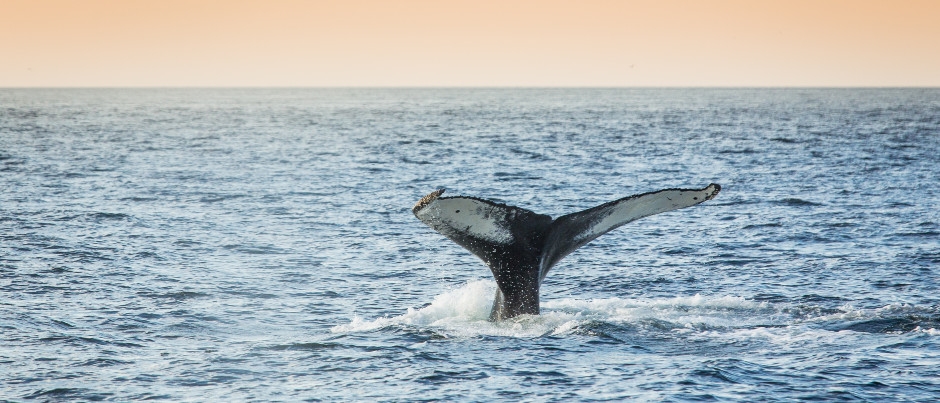
-
Humpback whale
Mathieu Dupuis
Tips for Identifying Whale Species
The maritime regions of Québec are some of the best places in the world to see whales. The tides, currents and unusual seabed topography in the St. Lawrence Estuary and parts of the Gulf of St. Lawrence provide favourable conditions for high concentrations of plankton and fish, creating an open-air buffet for marine mammals. As a result, you can observe up to 13 species of cetaceans in our regions. Did you know that in Côte-Nord, from Tadoussac to Blanc-Sablon, Route 138 is officially known as the Whale Route? Several whale species can also be observed along the south shore of the St. Lawrence, in Bas-Saint-Laurent (particularly as an access point to the Saguenay–St. Lawrence Marine Park) and in Gaspésie.
There are two types of whales:
- Toothed whales (8 species in Québec / 70 species worldwide)
- Baleen whales (5 species in Québec / 11 species worldwide)
To observe these giants of the sea, you have three options: a comfortable cruise in a sightseeing boat, a guided excursion in a Zodiac, or whale watching from the shore. In certain areas, the water is so deep that the whales swim very close to the coast!
To prepare you for your next whale-watching excursion, here are some tips to help you identify the most common species found in our regions.
TOOTHED WHALES
Atlantic white-sided dolphins
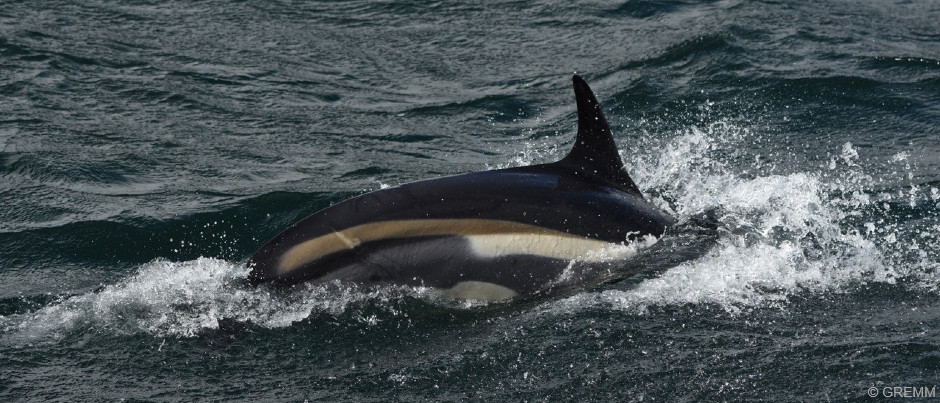
In Côte-Nord, Atlantic white-sided dolphins are most likely to be observed between Pointe-des-Monts and Havre-Saint-Pierre. This species can also be seen in Gaspésie, in the waters off Forillon National Park and Parc national de l’Île-Bonaventure-et-du-Rocher Percé. These dolphins swim in pods of hundreds of individuals and love to play in the wake of passing boats. They are fast, acrobatic swimmers that often leap in the air, exposing their whole body.
Characteristics:
- Black back, including fins and tail flukes
- White belly
- Greyish flanks with a narrow white streak leading to a yellowish tan patch
- Tall, sharply pointed dorsal fin that curves back
Belugas
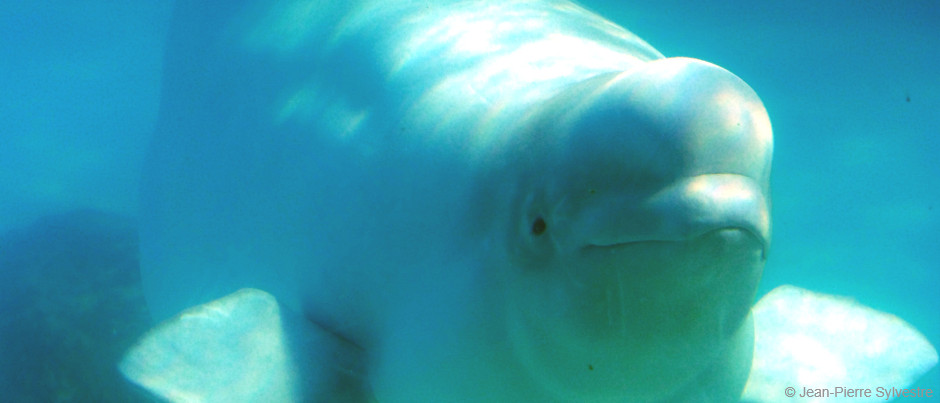
Belugas are the only whales to live year-round in the St. Lawrence Estuary. About 50 individuals from this endangered species frequent the waters found in Parc national du Fjord-du-Saguenay in Côte-Nord, where a lookout has been built to facilitate sightings. Belugas can also be seen from various islands in Bas-Saint-Laurent, such as Île Verte or Île aux Lièvres, as well as from the land-based Putep ’t-awt marine mammal observation site in Cacouna. Beluga whales swim slowly, usually in pods.
Characteristics:
- White skin (in adults)
- Melon-shaped head and very mobile neck
- Broad and short pectoral fins
Sperm whales
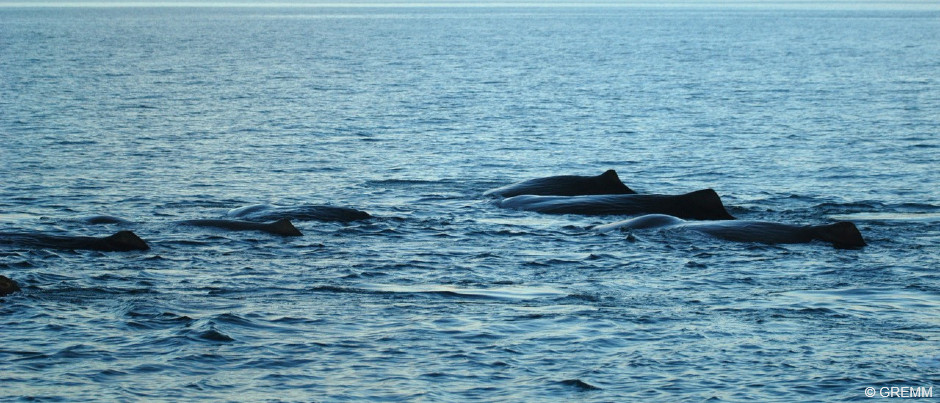
Sperm whales prefer very deep waters and can sometimes be seen in the St. Lawrence Estuary, particularly in the Tadoussac and Les Bergeronnes areas in Côte-Nord. You’ll probably recognize this whale since it was immortalized in Herman Melville’s Moby Dick. The sperm whale’s distinctive bushy blow is angled forward and to the left; it also slowly lifts its triangular-shaped tail very high out of the water before beginning a deep dive.
Characteristics:
- Large squarish head (about a third of total body length)
- Blowhole located on the left side of the head
- Dark wrinkled skin behind the head
- Hump-like dorsal fin
- Small bumps along back, from dorsal fin to tail flukes
- Triangular tail
BALEEN WHALES
Minke whales
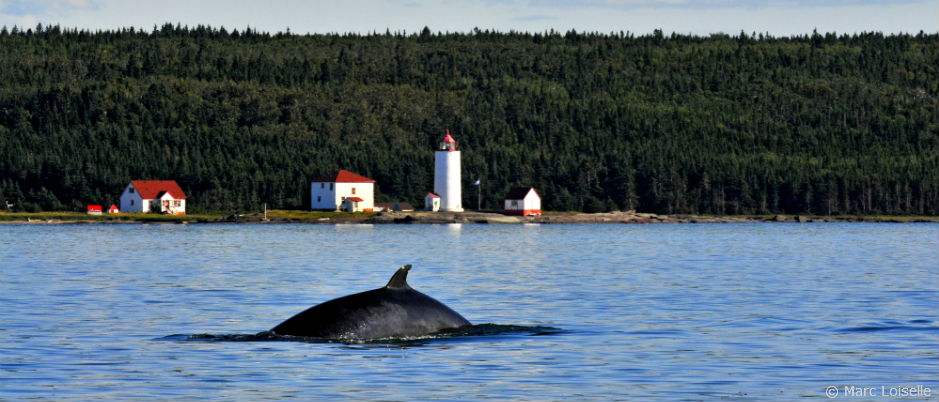
The smallest of the baleen whales can be observed in Côte-Nord near Tadoussac and between Pointe-des-Monts and Mingan, as well as in Gaspésie from Bonaventure Island or even from your car while driving along the north side of the peninsula on Route 132. If you visit the Île Verte Lighthouse, in Bas-Saint-Laurent, keep your eyes on the horizon! Minke whales arch their back to a great degree before diving, but their flukes don’t emerge from the water.
Characteristics:
- Grey back and flanks, pinkish white belly
- Distinctive white bands on pectoral fins
- Flattened pointed head
- Ventral pleats extending from the throat to just behind the pectoral fins
Humpback whales
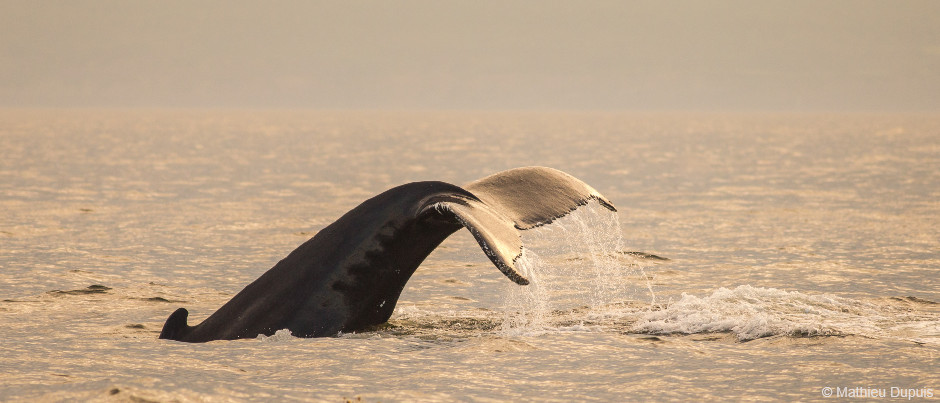
Humpbacks are commonly seen in Côte-Nord, in the Saguenay–St. Lawrence Marine Park as well in the Minganie area and along the Lower North Shore (between La Tabatière and the Strait of Belle Isle). They can also be spotted in Gaspésie, in the waters off Percé and in Gaspé Bay. These whales show their tail with every dive, much to the delight of whale-watchers! Humpbacks have a distinctive bushy blow that’s almost as wide as it is high. When they dive, they arch their back and roll forward slowly, showing off their dorsal fin and tail flukes.
Characteristics:
- Primarily black with white on pectoral fins, belly and the underside of flukes
- Broad head with round protuberances on the lower jaw
- Exceptionally long pectoral fins with small bumps along the edges
- Distinctive hump in front of a small dorsal fin
- Large and widely spaced ventral pleats extending to navel
- Serrated flukes that are pointed at the tips
North Atlantic right whales
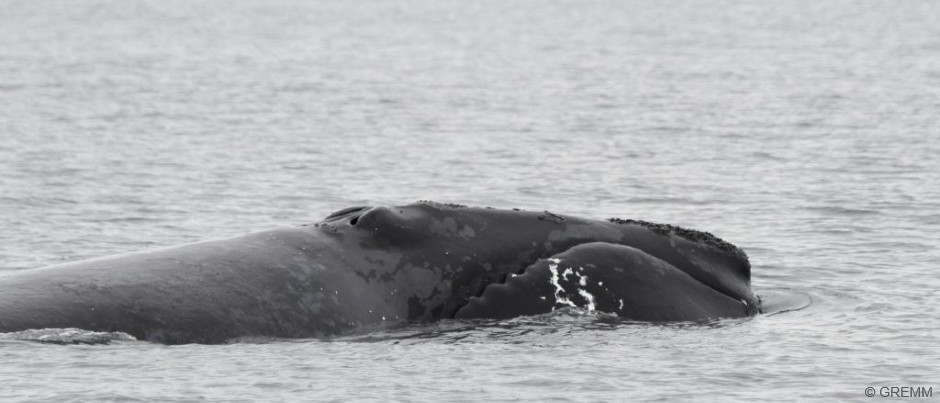
Round and chubby, North Atlantic right whales are increasingly observed along the Lower North Shore and in the Saguenay–St. Lawrence Marine Park. This species is incredibly friendly, so don’t be surprised if one approaches your boat! Their V-shaped blows can reach up to 5 metres (16 feet) high. These whales arch their back when diving and display their tail flukes.
Characteristics:
- Broad smooth back with no dorsal fin
- Mostly black with the occasional white blotches on belly
- White, bumpy growths on head called callosities
- Paddle-shaped pectoral fins
Fin whales
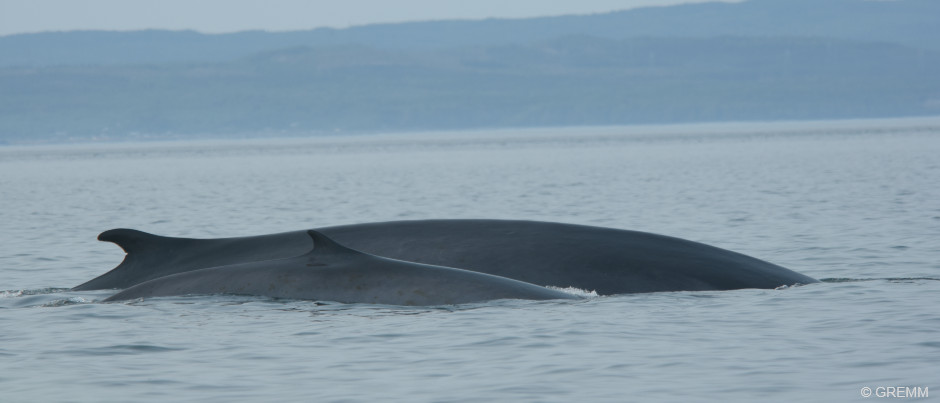
In Côte-Nord, the Tadoussac area is one of the best places to see fin whales, as are the waters between Pointe-des-Monts and Mingan. These cetaceans can also be observed off the tip of the Gaspé Peninsula and from Île Verte, in Bas-Saint-Laurent. The second largest animals on the planet, fin whales are also one of the fastest cetaceans and can dive to depths of 100 metres (330 feet), up to five times their length. When they surface, their loud and highly visible column-shaped blow can rise up to 4 to 6 metres (13 to 20 feet). You will then see their dorsal fin before they disappear under the water again.
Characteristics:
- Sleek, streamlined body
- Dark grey back and flanks
- White belly and right-side of lower jaw
- Distinct light grey chevrons behind the head
- Relatively small pointy pectoral fins
- Ventral pleats extending from throat to navel
Blue whales
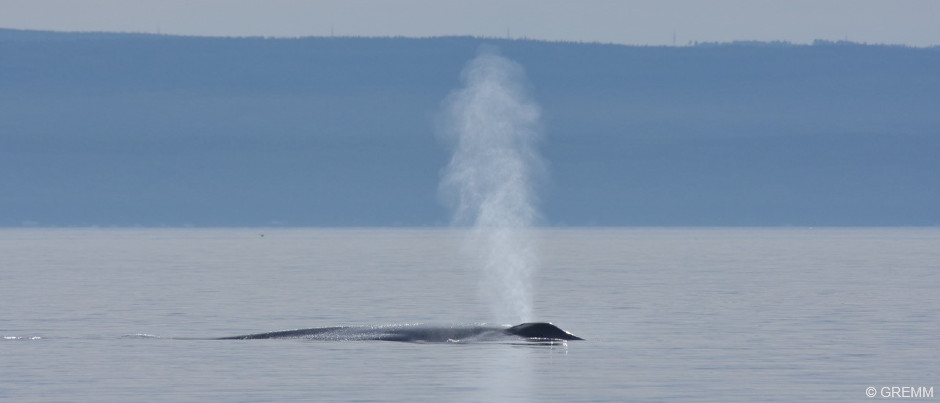
The largest animals on the planet, blue whales swim alone or in pairs. The St. Lawrence, particularly in the Les Escoumins and Minganie areas in Côte-Nord and in the Gaspé and Percé areas in Gaspésie, is one of the rare places in the world where this endangered species can be seen near the shore. Blue whales emit loud and explosive blows that can reach a height of 6 metres (20 feet). Their dorsal fin breaks the surface long after the blow is sighted. With any luck, you’ll also see their tail flukes before they plunge back under the surface.
Characteristics:
- Bluish grey body mottled with grey or greyish white
- Small dorsal fin set far back on the body
- Ventral pleats extending from throat to navel
For information about whale-watching excursions and sites to visit in our regions, consult our Whale Watching section.
Sources:
- Whales Online by the Group for Research and Education on Marine Mammals (GREMM)
- Découvrir les baleines et autres mammifères marins du Québec et de l’est du Canada by Pierre Richard and Jacques Prescott, Montréal: Éditions Michel Quintin, 2005

(0) comment